
The Gibson Girl was the personification of the feminine ideal of physical attractiveness as portrayed by the pen-and-ink illustrations of artist Charles Dana Gibson during a 20-year period that spanned the late 19th and early 20th centuries in the United States.[1] The artist saw his creation as representing the composite of "thousands of American girls".
Image

The Gibson Girl image that appeared in the 1890s combined elements of older American images of contemporary female beauty, such as the "fragile lady" and the "voluptuous woman". From the "fragile lady" she took the basic slender lines, and a sense of respectability. From the "voluptuous woman" she took a large bust and hips, but was not vulgar or lewd,[2] as previous images of women with large busts and hips had been depicted. From this combination emerged the Gibson Girl, who was tall and slender, yet with ample bosom, hips and buttocks. She had an exaggerated S-curve torso shape achieved by wearing a swan-bill corset. Images of her epitomized the late 19th- and early 20th-century Western preoccupation with youthful features and ephemeral beauty. Her neck was thin and her hair piled high upon her head in the contemporary bouffant, pompadour, and chignon ("waterfall of curls") fashions. The statuesque, narrow-waisted ideal feminine figure was portrayed as being at ease and stylish.
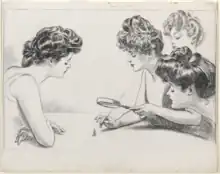
She was a member of upper middle class society, always perfectly dressed in the latest fashionable attire appropriate for the place and time of day. The Gibson Girl was also one of the new, more athletic-shaped women, who could be found cycling through Central Park, often exercised and was emancipated to the extent that she could enter the workplace.[3] In addition to the Gibson Girl's refined beauty, in spirit, she was calm, independent and confident, and sought personal fulfillment. She could be depicted attending college and vying for a good mate, but she would never have participated in the suffrage movement.
Taking part in the suffrage movement was something more associated with the New Woman, another cultural image of women that emerged around the same time as the Gibson Girl. As a more popular version of the New Woman, the Gibson Girl both undermined and sanctioned some women's desires for progressive sociopolitical change.[4] The New Woman was the more disconcerting of the two images at the time as she was seen as an example of change and disruption within the old patterns of social order, asking for the right to equal educational and work opportunities as well as progressive reform, sexual freedom and suffrage. Whilst the Gibson Girl took on many characteristics of the New Woman, she did so without involving herself in politics and thus did not appear to contemporaries at the time to be usurping traditionally masculine roles as the New Woman was deemed to. She therefore managed to stay within the boundaries of feminine roles without too much transgression.
Gibson depicted her as an equal and sometimes teasing companion to men.[5] She was also sexually dominant, for example, literally examining comical little men under a magnifying glass, or, in a breezy manner, crushing them under her feet. Next to the beauty of a Gibson Girl, men often appeared as simpletons or bumblers; and even men with handsome physiques or great wealth alone could not provide satisfaction to her. Gibson illustrated men so captivated by her looks that they would follow her anywhere, attempting to fulfill any desire, even if it was absurd. One memorable drawing shows dumbstruck men following a Gibson Girl's command to plant a young, leafless tree upside-down, roots in the air, simply because she wanted it that way. Most often, a Gibson Girl appeared single and uncommitted. However, a romance always relieved her boredom. Once married, she was shown deeply frustrated if romantic love had disappeared from her life, but satisfied if socializing with girlfriends or happy when doting on her infant child. In drawings such as these there was no hint at pushing the boundaries of women's roles; instead they often cemented the long-standing beliefs held by many from the old social orders, rarely depicting the Gibson Girl as taking part in any activity that could be seen as out of the ordinary for a woman.
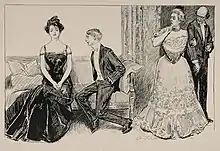
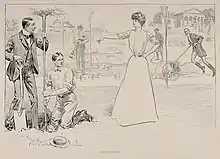
The artist believed that the Gibson Girl represented the beauty of American women:
I'll tell you how I got what you have called the 'Gibson Girl.' I saw her on the streets, I saw her at the theatres, I saw her in the churches. I saw her everywhere and doing everything. I saw her idling on Fifth Avenue and at work behind the counters of the stores ... I haven't really created a distinctive type, the nation made the type. What Zangwill calls the 'Melting Pot of Races' has resulted in a certain character; why should it not also have turned out a certain type of face? ... There isn't any 'Gibson Girl,' but there are many thousands of American girls, and for that let us all thank God.[6]
Gibson believed that America's women would become more beautiful:
They are beyond question the loveliest of all their sex ... In the United States, of course, where natural selection has been going on, as elsewhere, and where, much more than elsewhere, that has been a great variety to choose from. The eventual American woman will be even more beautiful than the woman of to-day. Her claims to that distinction will result from a fine combination of the best points of all those many races which have helped to make our population.[6]
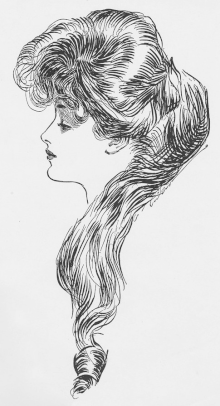
Many women posed for Gibson Girl-style illustrations, including Gibson's wife, Irene Langhorne, who may have been the original model, and was a sister of Viscountess Nancy (Langhorne) Astor. Other models included Mabel Normand,[7] Evelyn Nesbit,[8] Minnie Clark,[9] and Clara B. Fayette.[10] The most famous Gibson Girl was probably the American-British stage actress, Camille Clifford, whose high coiffure and long, elegant gowns that wrapped around her hourglass figure and tightly corseted wasp waist defined the style.[11]
Among the many "Gibson Girl" illustrators were Howard Chandler Christy whose work celebrating American "beauties" was similar to Gibson's, and Harry G. Peter, who was most famous for his art on Wonder Woman comics.
In the newly developing art of cinema, although most leading actresses were at the cutting style of the day, the ones who came to embody it best were the Biograph girls, Florence Lawrence and to a more ingénue side of it, Mary Pickford. They personified and catapulted the cult of the ideal woman for the masses beyond American borders. Camille Clifford, a woman known as the "ideal Gibson Girl", posed for various photographers and produced photographs that exemplified the physical characteristics of the Gibson Girl.
Popularity
Some people argue that the Gibson Girl was the first national beauty standard for American women. Gibson's fictional images of her published in newspapers and magazines during the Belle Époque were extremely popular.[12] Merchandise bearing her image included saucers, ashtrays, tablecloths, pillow covers, chair covers, souvenir spoons, screens, fans, and umbrella stands.[13]
By the outbreak of World War I, changing fashions caused the Gibson Girl to fall out of favor as women favored practical clothing compatible with changing times over the elegant dresses, bustle gowns, shirtwaists, and terraced, floor-length skirts favored by the Gibson Girl. The image was not forgotten, however, with the USAAF World War II-era SCR-578, and the similar post-war AN/CRT-3, survival radio transmitters carried by aircraft on over-water operations being given the nickname "Gibson Girl" because of their "hourglass" shape, which allowed them to be held stationary between the legs while the generator handle was turned.[14]
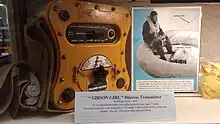
See also
References
- ↑ "The Gibson Girl’s America: Drawings by Charles Dana Gibson" at the Library of Congress
- ↑ Mazur, Allan (August 1986). "U.S trends in feminine beauty and over-adaptation". Journal of Sex Research. 22 (3): 287. doi:10.1080/00224498609551309.
- ↑ Mazur, Allan (August 1986). "U.S trends in feminine beauty and over-adaptation". Journal of Sex Research. 22 (3): 288. doi:10.1080/00224498609551309.
- ↑ Patterson, Martha. H. (2008). Beyond the Gibson Girl: Re-imagining the America New Woman 1895-1915. Chicago: University of Illinois Press.
- ↑ American Beauties
- 1 2 Marshall, Edward (1910-11-20). "The Gibson Girl Analyzed By Her Originator". The New York Times. Retrieved 2010-11-21.
- ↑ "Eyes on the pies: How Mabel Normand, Chaplin's mentor, changed cinema". The Guardian. London. 7 September 2018.
- ↑ Allen, Erin (2013-04-05). "A Turn-of-the-Century "True Hollywood Story" | Timeless". The Library of Congress. Retrieved 2023-03-27.
- ↑ Fine Lines: American Drawings from the Brooklyn Museum. London: Giles, 2013. ISBN 9781907804144. Catalog of an exhibition held March 8 to May 26, 2013. p. 112, "Best known as the face of the original 'Gibson Girl', Clark appeared in Charles Dana Gibson's famous and widely emulated illustrations of fashionable, young, middle-class women, images that set the standard for feminine beauty in that period"; p. 115, "It is believed that Minnie Clark (life dates unknown) ... served as the original model for the Gibson Girl."
- ↑ "CLARA B. FAYETTE, 88, A 'GIBSON GIRL' MODEL". The New York Times. March 7, 1976. p. 47.
- ↑ "Why Do They Call Me A Gibson Girl? Miss Camille Clifford Singing The Song Which Reached Miss Edna May's Heart". The Bystander. XII (149): 83. October 10, 1906. Retrieved 2009-07-27.
- ↑ Mitchell, John Ames (November 15, 1894). "Bookishness: The Gibson Girl". Life. Vol. XXIV, no. 620. pp. 312–313. Retrieved 27 July 2009 – via Google Books.
Mr. Gibson has a great responsibility on his shoulders, and if he once fully realizes it, it will keep him awake nights. I wonder if he knows that there are thousands of American girls, from Oshkosh to Key West, who are trying to live up to the standard of his girls.
- ↑ "Charles Dana Gibson and the Gibson Girls". livelyroots.com. Archived from the original on 31 December 2003. Retrieved 26 January 2015.
There was merchandising of the Gibson Girl on the level of Mickey Mouse or Star Wars. Large size books ("table albums", they were called), china plates and saucers, ashtrays, tablecloths, pillow covers, chair covers, souvenir spoons, screens, fans, umbrella stands ... all bore the image of Gibson's creations. There was even a wallpaper for bachelor apartments, with the lovely Gibson faces in endless array. A popular turn-of-the-century hobby, pyrography, saw people burning the Gibson Girl into leather and wood; and the image was traced and stitched into handkerchiefs. There were plays, songs, and even a movie based on his creation.
- ↑ Septer, Dirk (2016). Lost Nuke: The Last Flight of Bomber 075 (Revised ed.). Heritage House Publishing Co. p. 91. ISBN 978-1772031287.
Further reading
- Patterson, Martha H. (2005). Beyond the Gibson Girl: Reimagining the American New Woman, 1895-1915. University of Illinois Press. ISBN 9780252030178.
- Patterson, Martha H. (2008). The American New Woman Revisited: 1894-1930. New Brunswick: Rutgers University Press. ISBN 978-0813542966.
- Pollard, Percival (June 1897). "Sundry "American Girls" in Black-And-White". The Book Buyer: A Review and Record of Current Literature. XIV (5): 474–478. Retrieved July 27, 2009.
External links
- Vreeland, Diana. American women of style : an exhibition. Metropolitan Museum of Art Publications. OCLC 907998085.